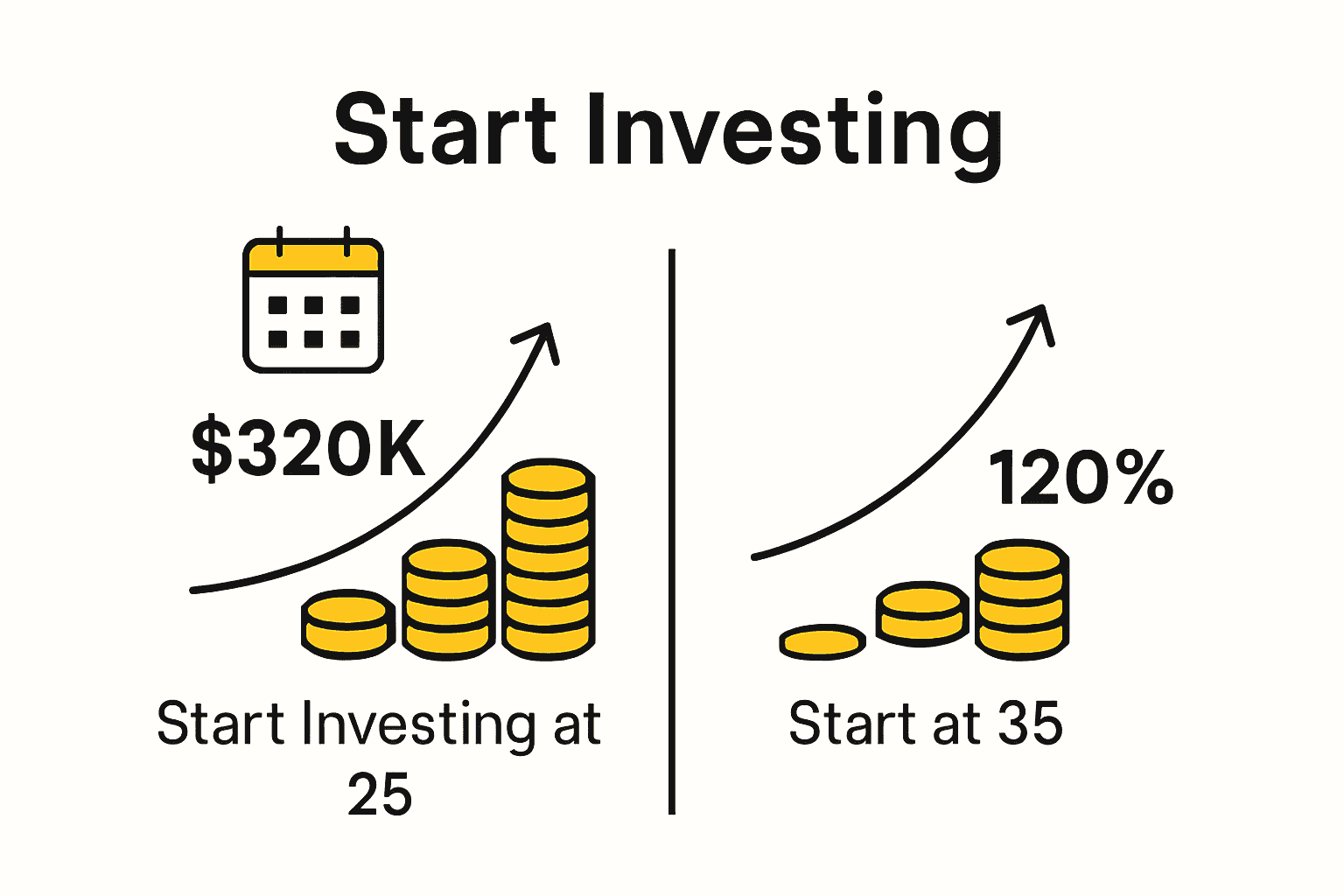Over 60 percent of lifelong wealth accumulation comes from simply starting early with your investments. For many people, deciding when and how to put money to work feels intimidating, especially with so much conflicting advice out there. Understanding the core principles of early investment not only helps you build a more secure financial future but also puts the power of compounding and risk management on your side for years to come.
Table of Contents
- Defining Early Investment And Its Principles
- Compounding Interest: The Power Of Time
- Reducing Risks Through Early Investing
- Building Wealth: Case Studies And Examples
- Common Myths And Mistakes To Avoid
Key Takeaways
| Point | Details |
|---|---|
| Start Early | Begin investing as soon as possible to leverage the power of time and compound growth. Even small amounts can accumulate significantly over time. |
| Diversification is Key | Spread investments across various asset classes to minimize risk and enhance portfolio resilience against market volatility. |
| Embrace Compound Interest | Utilize compound interest to maximize wealth; the longer your money is invested, the more it grows through reinvested earnings. |
| Avoid Common Myths | Don’t let misconceptions about investing prevent you from starting. Focus on consistency and a clear strategy rather than waiting for the perfect moment. |
Defining Early Investment and Its Principles
Early investment is the strategic financial practice of allocating money toward wealth-building opportunities during your younger years, typically when you have more time to leverage compound growth. Investing early means understanding that time is your most powerful financial asset, allowing your money to grow exponentially through sustained, disciplined commitment.
The fundamental principles of early investment revolve around several core strategies. First, start as soon as possible – even small amounts invested consistently can transform into substantial wealth over decades. Secondly, diversification becomes critical, spreading your investments across different asset classes to minimize risk. Thirdly, harness the power of compound interest, which enables you to earn returns not just on your initial investment, but on the accumulated earnings as well. Learn more about building an investment portfolio to understand these nuanced strategies.
Key principles of early investment include:
- Consistency in contributions
- Long-term perspective
- Risk tolerance assessment
- Regular portfolio rebalancing
- Continuous financial education
Understanding early investment isn’t just about money management – it’s about creating a financial roadmap that provides security, flexibility, and potential prosperity. The earlier you begin, the more opportunities you create for financial growth and personal freedom. Your future self will thank you for making smart, informed decisions today.

Compounding Interest: The Power of Time
Compound interest is the financial phenomenon where you earn returns not just on your original investment, but also on the accumulated interest over time. As irjaeh Research highlights, this mechanism is a critical wealth-building strategy that transforms modest investments into substantial financial reserves through patient, disciplined investing.
The magic of compounding works like a snowball effect. Imagine investing $1,000 annually with an average annual return of 7%. After 10 years, you’re not just earning returns on your $1,000 yearly contributions, but also on all previously accumulated earnings. According to the research, maintaining financial discipline and consistently reinvesting earnings are key to maximizing this powerful wealth-generation mechanism. Explore safe investment options to understand practical implementation strategies.
Key advantages of compound interest include:
- Exponential growth potential
- Minimal additional effort required
- Reduced dependence on large initial investments
- Natural wealth accumulation mechanism
- Long-term financial security
Time is the most crucial ingredient in the compounding recipe. The earlier you start, the more opportunities you create for your money to grow. A 25-year-old investing $200 monthly will accumulate significantly more wealth by retirement compared to someone starting at 35 – simply because of the extra decade of compounding. Your financial future isn’t just about how much you invest, but when you start investing.
Reducing Risks Through Early Investing
Risk management is a crucial aspect of successful investing, and starting early provides unique opportunities to develop a robust, resilient investment strategy. By beginning your investment journey when you’re younger, you create multiple layers of financial protection that can significantly minimize potential losses and maximize long-term gains.
One of the most powerful risk reduction strategies is diversification. When you start investing early, you have more time to spread your investments across various asset classes like stocks, bonds, real estate, and mutual funds. This approach helps protect your portfolio from market volatility. Learn more about financial risk management strategies to understand how to create a balanced investment approach that mitigates potential downturns.
Key risk reduction techniques for early investors include:
- Gradual, consistent investment contributions
- Regular portfolio rebalancing
- Investing in low-cost index funds
- Maintaining an emergency cash reserve
- Avoiding emotional investment decisions
Early investors also benefit from having more time to recover from potential market fluctuations. A young investor can weather short-term market downturns because they have decades to recoup any temporary losses. By understanding and implementing smart risk management techniques, you transform potential financial uncertainty into a strategic opportunity for long-term wealth building. Your early investments aren’t just about making money – they’re about creating a financial safety net that grows stronger with time.
Building Wealth: Case Studies and Examples
Real-world examples powerfully illustrate the transformative potential of early investing. According to National Bureau of Economic Research, individuals who start investing in their twenties can accumulate substantially more wealth compared to those who delay investing until later in life. These case studies reveal the extraordinary impact of time and consistent financial strategy.
Consider Sarah, a software engineer who began investing $300 monthly at age 25 with an average 7% annual return. By age 55, her initial investment of approximately $108,000 would grow to nearly $500,000. In contrast, her colleague Mike, who started the same investment strategy at 35, would only accumulate around $240,000 – demonstrating how a decade of early investing can dramatically alter financial trajectories.
 Learn about setting smart financial goals to replicate such successful investment approaches.
Learn about setting smart financial goals to replicate such successful investment approaches.
Key insights from wealth-building case studies include:
- Starting early matters more than initial investment amount
- Consistent contributions trump sporadic large investments
- Patience and discipline are critical wealth-building traits
- Compound interest is a powerful long-term wealth generator
- Diversification reduces overall investment risk
These real-world examples underscore a fundamental truth: wealth accumulation is less about how much you earn, and more about how strategically and early you invest. Your financial future isn’t predetermined – it’s a result of intentional, informed decisions made consistently over time. By understanding and applying these principles, you can transform modest contributions into a robust financial foundation.
Common Myths and Mistakes to Avoid
Early investing is fraught with misconceptions that can derail even the most well-intentioned financial strategies. Many potential investors become paralyzed by myths that prevent them from taking the critical first steps toward building wealth. Understanding and dismantling these common misconceptions is crucial for developing a successful long-term investment approach.
One of the most prevalent myths is that you need substantial money to start investing. In reality, small, consistent contributions can grow significantly over time. Another dangerous misconception is the belief that investing is only for wealthy individuals or financial experts. Explore the most common investing mistakes to avoid and learn how to sidestep these typical pitfalls that can hinder your financial growth.
Common investment myths and mistakes include:
- Waiting for the “perfect” time to invest
- Trying to time the market
- Investing without a clear strategy
- Allowing emotions to drive investment decisions
- Neglecting to diversify your investment portfolio
- Failing to regularly review and rebalance investments
- Focusing solely on short-term gains
Successful investing is less about having perfect knowledge and more about developing consistent habits. Recognize that everyone starts somewhere, and the biggest mistake is not starting at all. Your investment journey is a marathon, not a sprint. By understanding these myths and avoiding common pitfalls, you can create a more robust and confident approach to building long-term wealth. Remember, the most powerful investment you can make is in your financial education and disciplined approach.
Take Control of Your Financial Future by Investing Early
Understanding the power of early investment is the first step toward building lasting wealth and reducing financial risks. This article breaks down the essential principles like consistency, diversification, and the magic of compound interest that can transform even small contributions into significant financial security. If you find yourself worried about where to begin or how to keep your investments on track, then you are not alone. Many hesitate because of myths or uncertainty about risk management.
Now is the perfect time to make a move. Explore actionable strategies in setting smart financial goals and avoid common pitfalls with our guide on 7 common investing mistakes. For personalized guidance tailored to your unique situation, visit finblog.com and take advantage of expert insights and resources designed to help you start strong and stay consistent. Your future self will thank you for the decision you make today.
Frequently Asked Questions
What is early investment and why is it important?
Early investment is the practice of allocating funds towards wealth-building opportunities at a young age. It’s important because starting early allows individuals to harness compound interest, increase financial security, and create more opportunities for financial growth over time.
How does compound interest work in early investment?
Compound interest means earning interest not only on your initial investment but also on the interest that accumulates over time. This exponential growth mechanism can significantly increase the value of investments made early, making it crucial for building wealth.
What are the risks associated with early investing?
While investing early can mitigate risks through diversification, potential risks include market volatility and short-term losses. However, early investors typically have more time to recover from market fluctuations, making risk management strategies essential for long-term success.
What are common misconceptions about early investing?
Common misconceptions include the belief that you need a large amount of money to start investing or that investing is only for the wealthy. In reality, even small, consistent contributions can grow significantly over time, and anyone can invest with proper knowledge and strategy.










